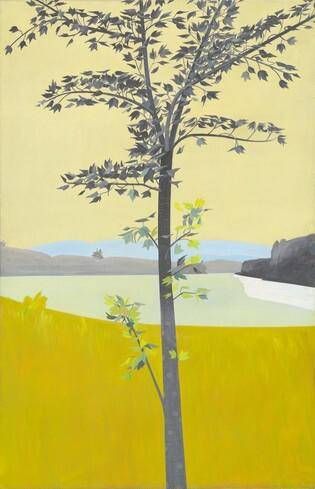
Swamp Maple (4:30)
Although best known for his figure paintings, often set in and around Manhattan, Alex Katz is equally a painter of Maine, where he has summered for decades. Swamp Maple (4:30) is one of his largest landscapes in every sense—at once monumental and unstable, fast and slow, flat and deep, hard and soft, general and particular, observed and abstract.
Katz captured the glow of weak sun on leaf and water and the contrasting textures of soft grass and rough bark (nicely conveyed by drying cracks, which the artist left intentionally rather than painting over them). The color choices, such as the tan sky and the white reflection of the black shore, are memorable and puzzling. The time of day, as indicated in the title, is 4:30 (in the afternoon), but perhaps the precise time is not so important, given Katz' stated goals of capturing an "overall light" in "the present tense." Temporality is complicated by process: Katz makes rapid oil-on-masonite sketches outdoors, then returns to the studio for laborious work.
Where are we? The absence of a viewpoint or standpoint is aided by radical cropping, a Katz trademark: "A lot of these paintings don't have much of a floor," he remarks slyly, and indeed the handling of the grass suggests a plane slipping away. Space is deepened by aerial perspective (the pale blue hills), then drained by the color of the sky, which sits on the surface. The tree is not in the landscape so much as in front of it, a strangely central repoussoir, perhaps even a stand-in for the artist or the beholder who stretches out his or her limbs to the limits of the scene, alive to every breeze. Is the artist a cool observer or a passionate identifier? The question has a distinguished tradition: it can be equally asked of Paul Cézanne and his beloved pine trees, or Gustave Courbet and his oak.
Katz steered his own course throughout the 1960s, paying close attention to artists as diverse as Barnett Newman, James Rosenquist, Fairfield Porter, and Al Held, who had a neighboring studio in New York for much of that decade. Swamp Maple (4:30) rivals the scale of abstract expressionism, borrows the language of hard-edge abstraction, and steers a course between the softness of plein-air painting and the slickness of pop art.
Credit: Gift of the Collectors Committee
1968
Oil on linen
365.8 x 236.2 cm
2008.34.1
Image and text © National Gallery of Art, 2020
Where you'll find this

National Gallery of Art
Permanent collection





